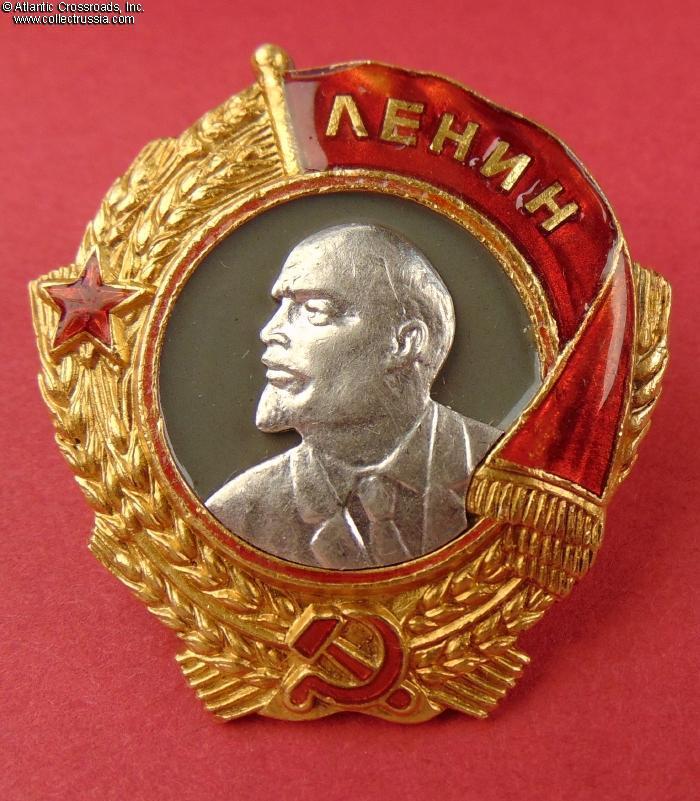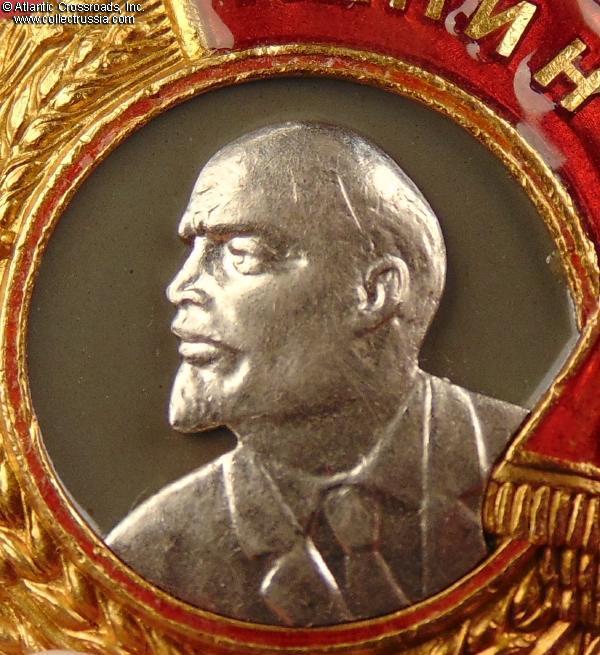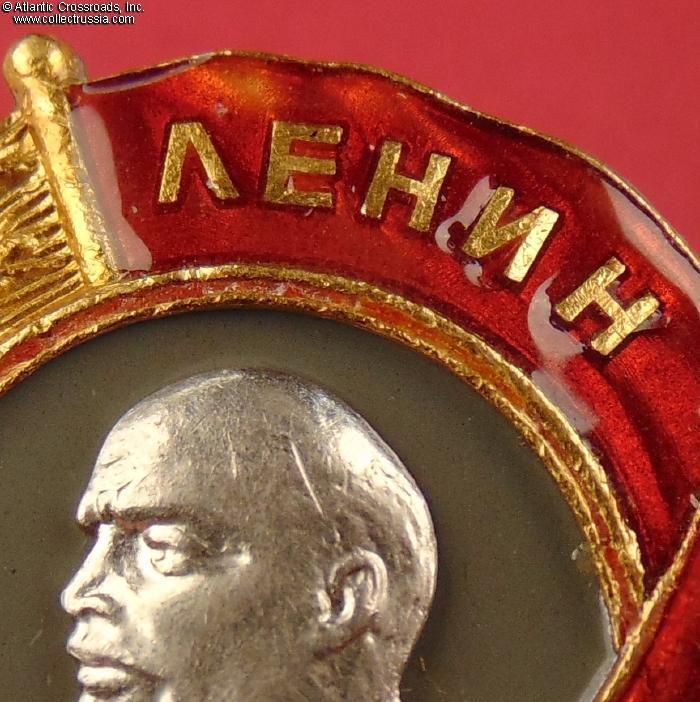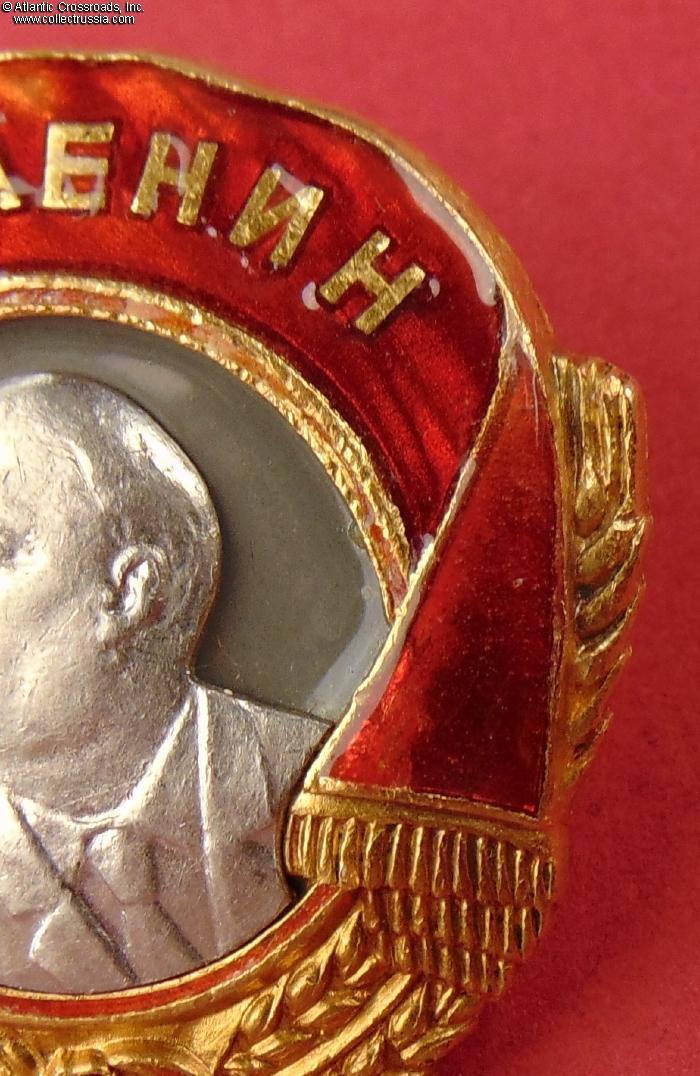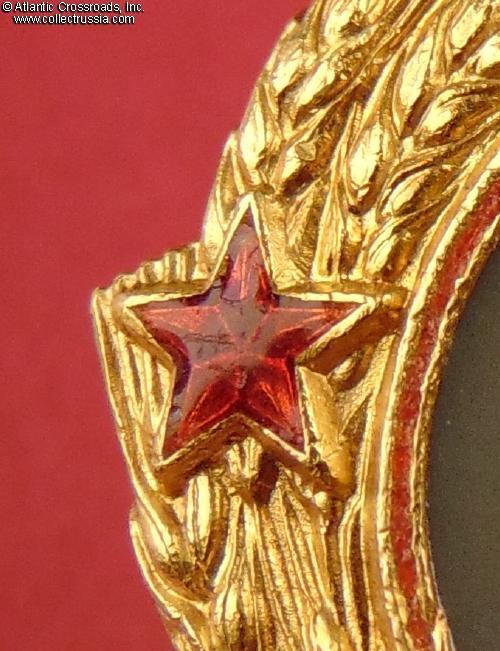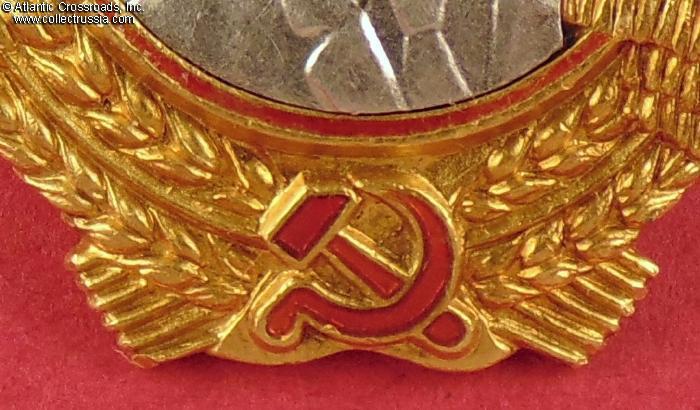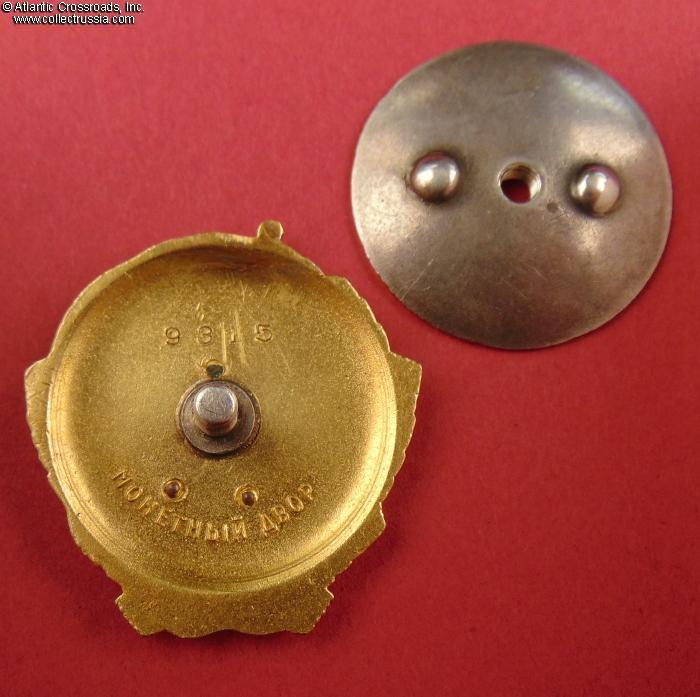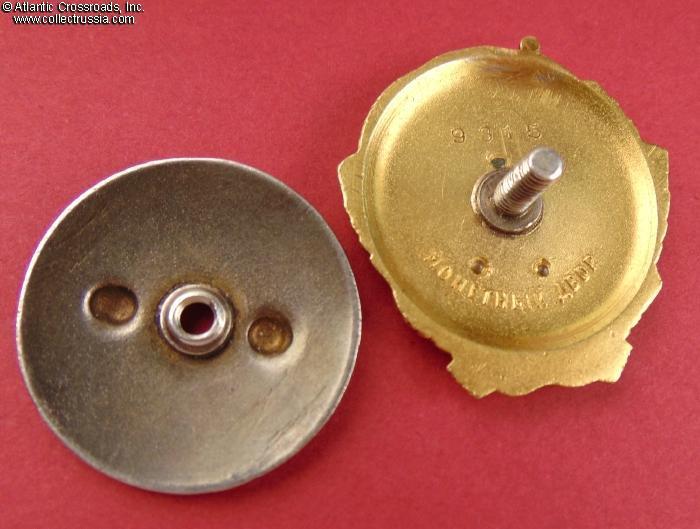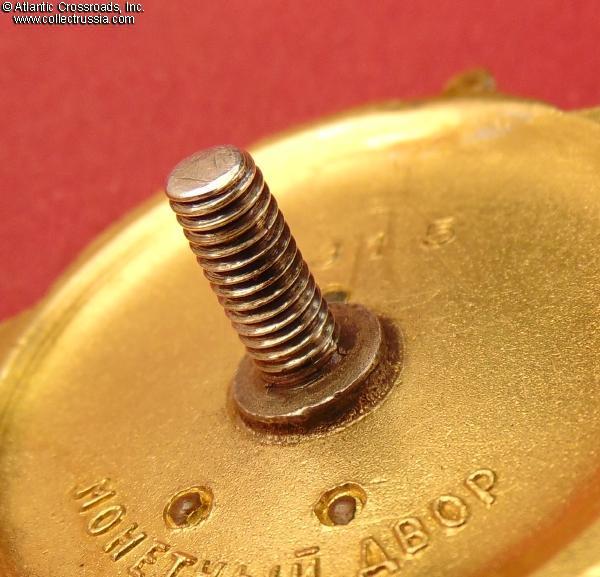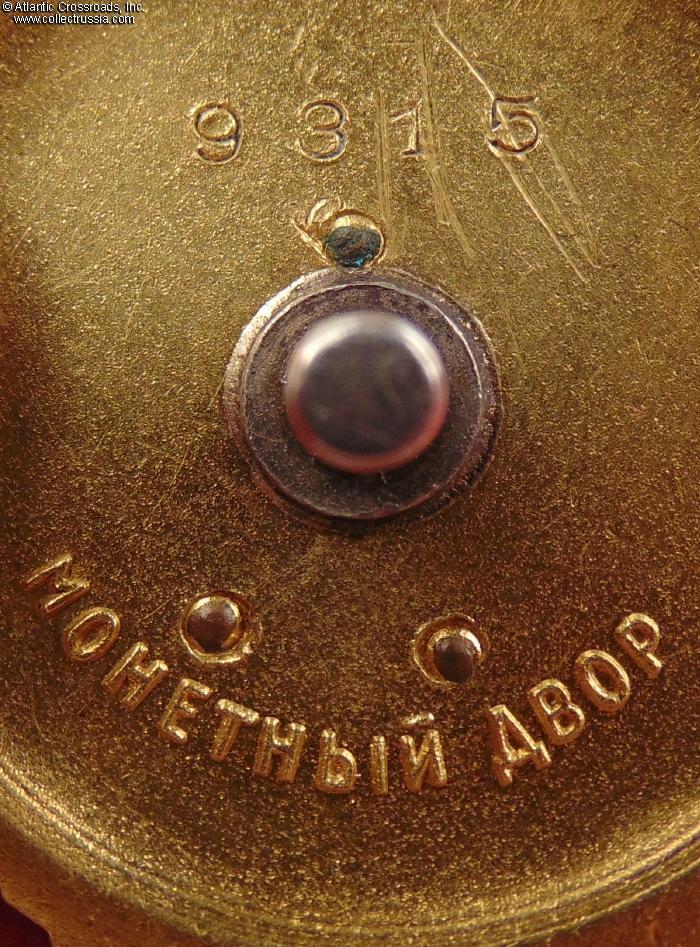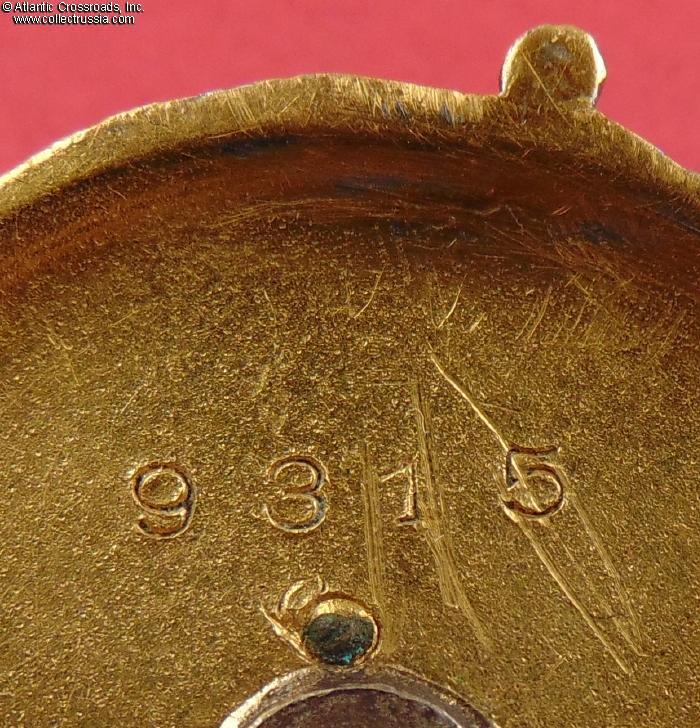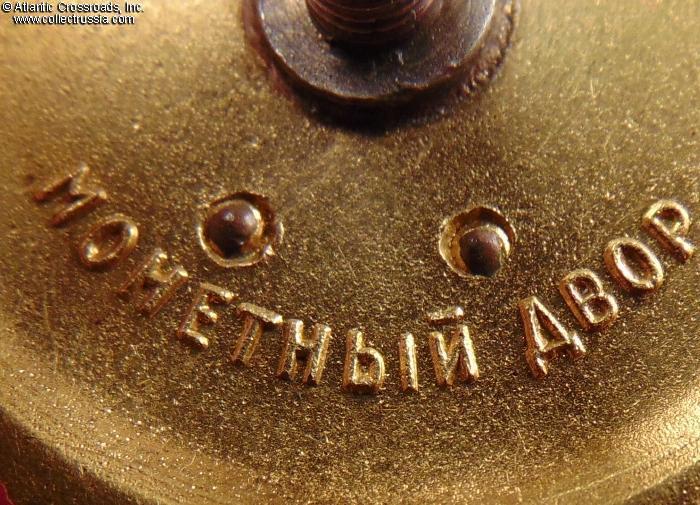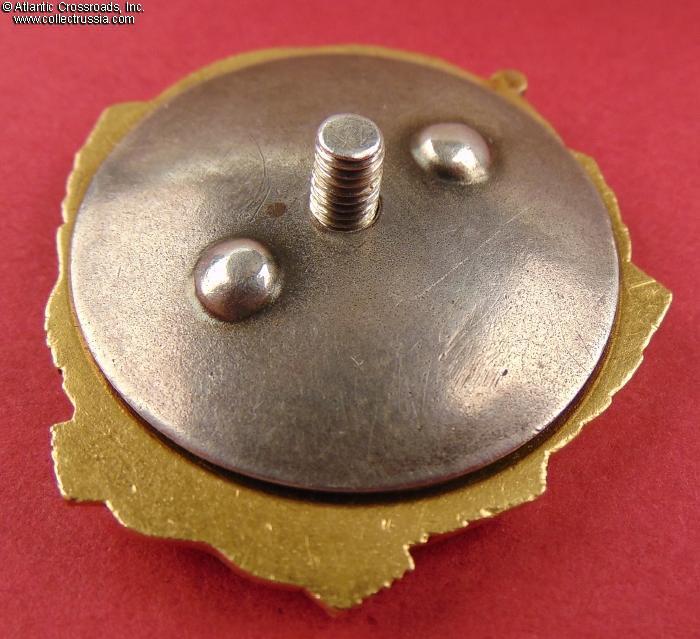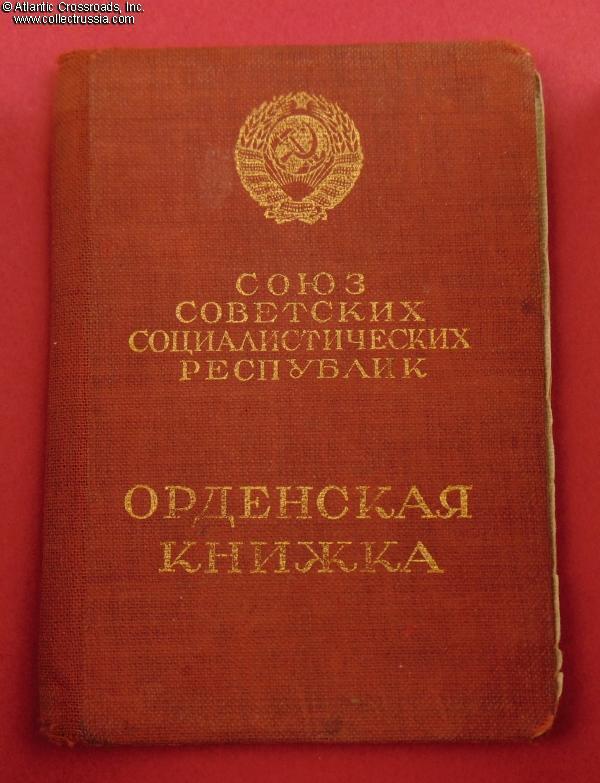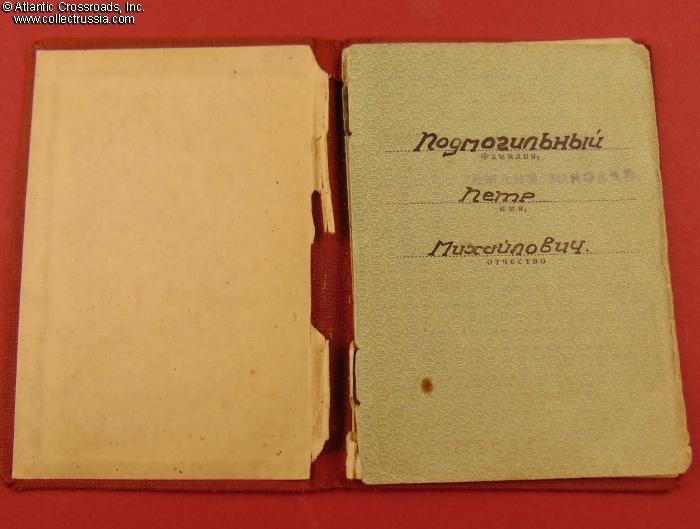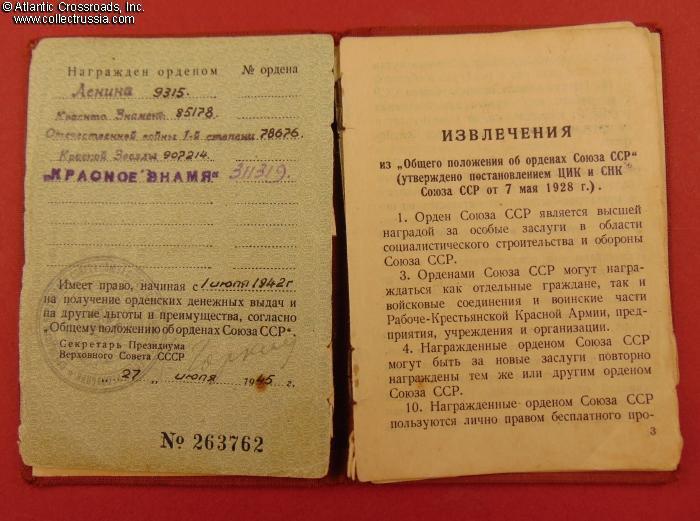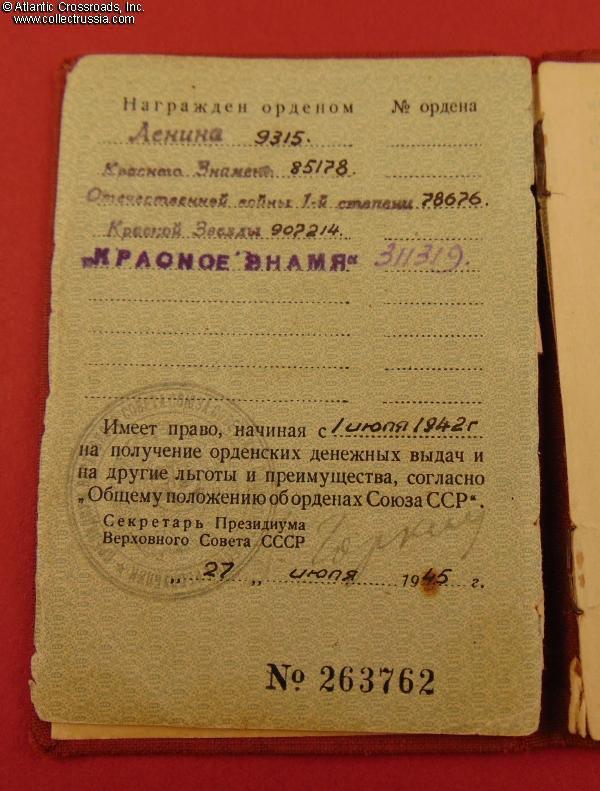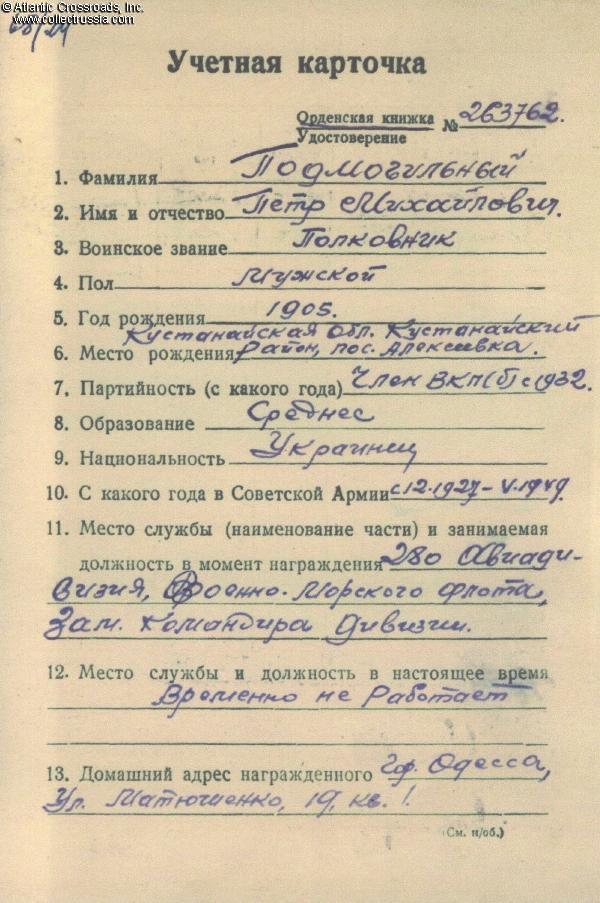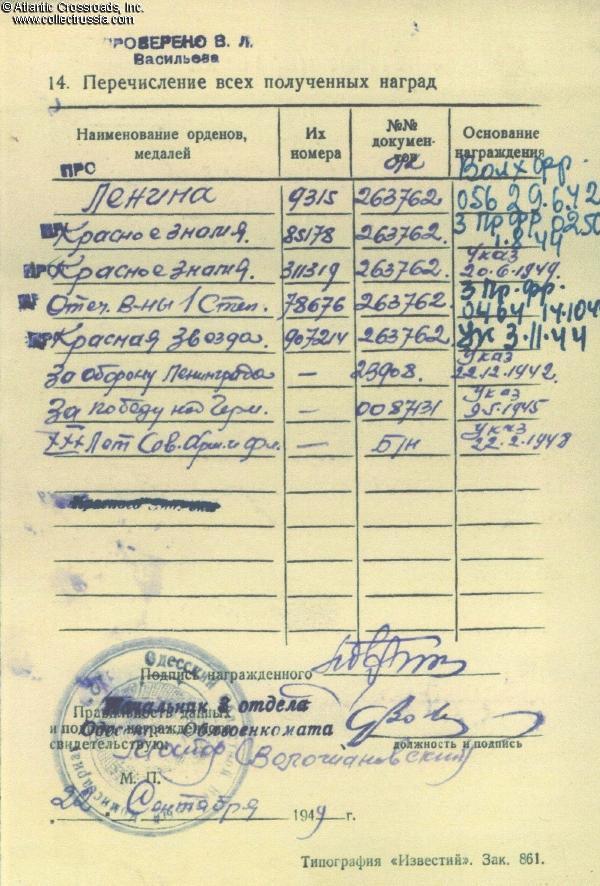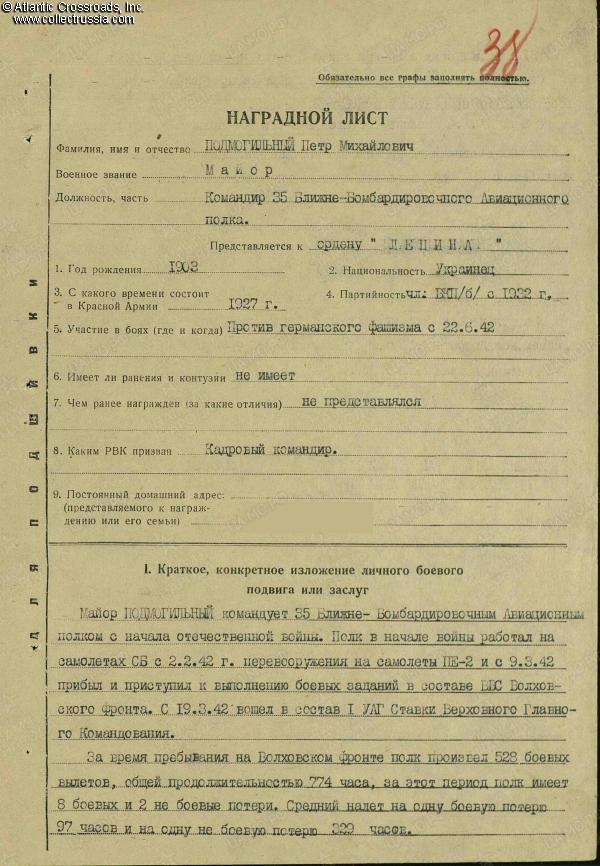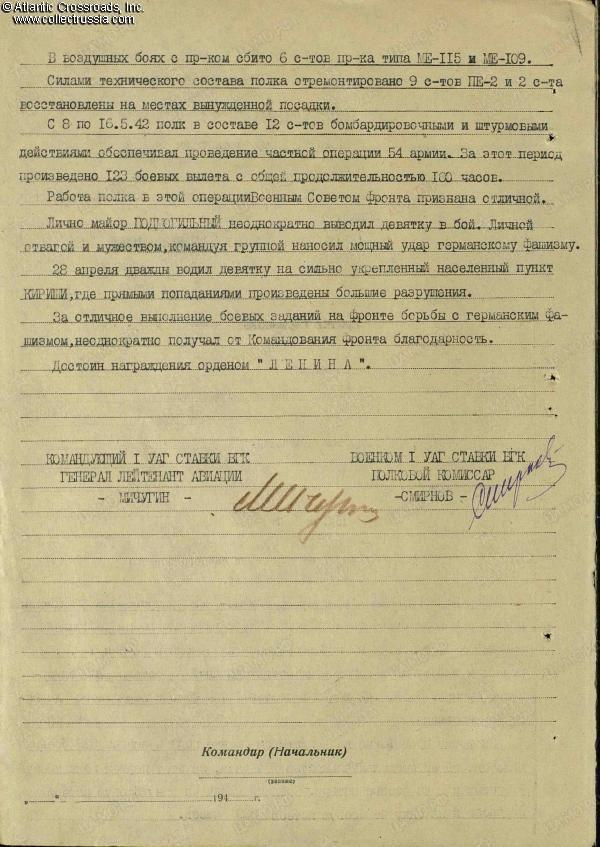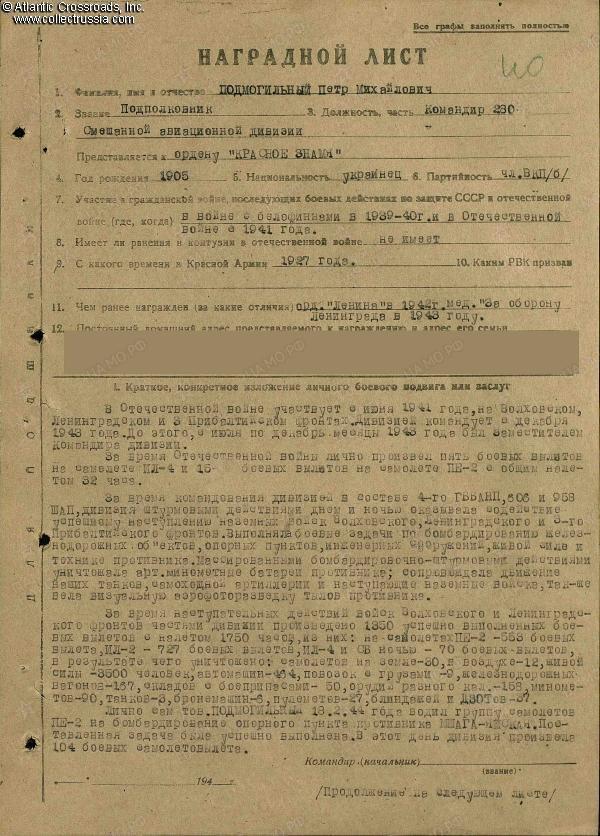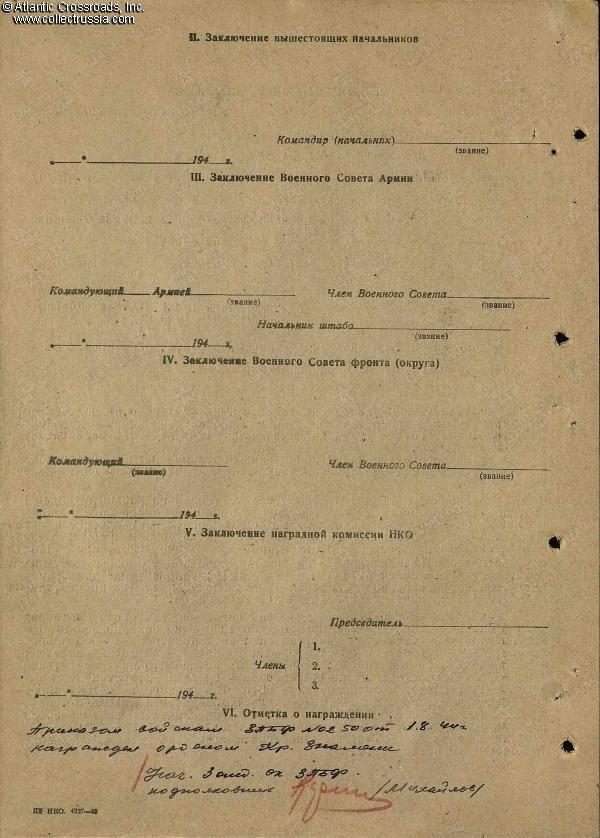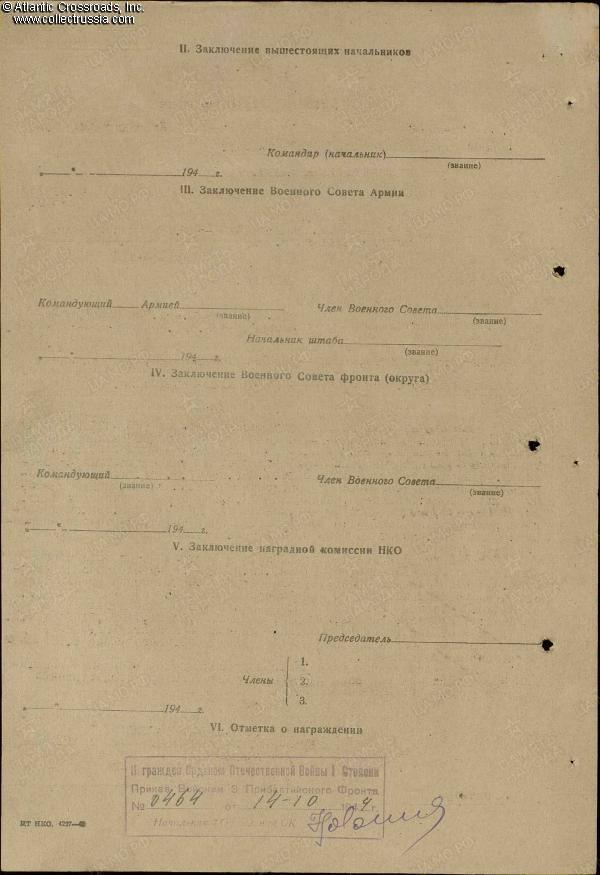Order of Lenin, Type 4, Variation 2, #9315, with a document, awarded on 29 June 1942 to Major Petr Podmogilnyi (Петр Михайлович Подмогильный), Commander of the 35th Short-Range Bomber Regiment.
The order is in 23 K gold, platinum, and enamels. Measures 38.9 mm in height (from the bottom of the wreath to highest point of the banner, not including the flagpole finial), 38.4 mm in width; weighs 36.2 g without the screw plate. Features two-word word "Monetnyi Dvor" mint mark and single-tier screw post base. The number is stamped in standard manner above the screw post.
In fine condition. The enamel on the banner is partly replaced with epoxy-based compound; the repair was done in an "old fashion", apparently decades ago; although the layer of replacement covers the entire surface of the banner, some of the original enamel is still present underneath. The red enamel on the hammer & sickle emblem, star and band around the center medallion is original and largely intact, having only some tiny contact marks and microscopic surface flakes, all of them practically invisible to the naked eye.
The grey enamel on the background of the center medallion is essentially perfect, having only a couple of minuscule contact marks that are nearly unnoticeable. The platinum bas-relief portrait of Lenin shows no wear detectable without magnification; its details are perfect and crisp. The golden wreath is likewise completely free of noticeable dings or scratches. The order has not been converted to suspension and retains its original full-size screw post, over 10 mm long measured from the screw post base. An original period screw plate in silver is included.
The Order Booklet #263762 was issued on 27 July 1945. The Order of Lenin was one of the first four entries made when the document was originally filled-out; these also include the Order of the Red Banner #85179, Order of the Patriotic War, 1st cl. #78676, and Order of the Red Star #907214. Later, another Order of the Red Banner, #311319, was added to the list as was customary. The date for the start of special privileges is 1 July 1942, which corresponds with a June 1942 date of the award decree for the Order of Lenin, chronologically the first decoration.
The document is in fair to good condition. The cloth binding of the cover is well-preserved and clean, showing only a minimal wear to the corners, while the gold impression of the state seal and lettering remains bright. The internal pages are loose, and the first of them - the one that had a provision for a photograph - is missing. All the other pages are present. The page containing all the important data such as the name of the recipient and list of awards has only a couple of minor spots and is free of significant wear or soiling.
Petr Podmogilnyi was born in 1905 to an ethnically Ukrainian family in a village of Kustanay region (today's Kostanay, Kazakhstan). He joined the military in 1927, probably by enrolling in a military aviation school, and in 1939-40 fought in the Winter War against Finland. At the beginning of the Patriotic War in June 1941, Podmogilnyi had the rank of major and was the commander of the 35th Short-Range Bomber Regiment. The unit, initially equipped with Tupolev SB ("Hight-speed Bomber", aka ANT-40) aircraft, was re-armed in the early months of 1942 with the far more modern Pe-2 dive bombers. A part of the 1st Strike Aviation Group of the Reserves of the Supreme Command, the regiment was deployed in support of the Volkhov Front (army group) attacking on the Lyban axis with the eventual goal of relieving Leningrad. From March - April 1942, the regiment's pilots completed 528 sorties and shot down six enemy airplanes, identified in the subsequent award recommendation as "Me-109" (Messerschmitt Bf 109 fighter) and "Me-115" (the latter designation is clearly a typo, likely meant to be Me-110, i.e. Bf-110 twin-engine fighter). During the same period the regiment suffered eight combat losses of its own aircraft and two non-combat losses.
On 23 April, the Volkhov Front war temporarily disbanded, with its units re-subordinated to the Leningrad Front. Maj. Podmogilnyi's unit remained in the same area of operations and was particularly effective from 8-16 May 1943, when it supported the 54th Army in the area of Pogostye and Kirishi just south of Lake Ladoga. Numbering just 12 aircraft at the time, the regiment managed to conduct 123 sorties within this short period and earned an excellent rating from the military council of the Front.
On many occasions Podmogilnyi personally led nine-plane formations into combat. On 28 April, he led two such missions on an attack on the heavily fortified town of Kirishi, one of the two small bridgeheads the Germans held on the Volkhov River. The strikes resulted in direct hits with significant destruction reported inside the town.
On 29 June 1942, Podmogilnyi was awarded with the Order of Lenin, the highest Soviet decoration and his first of the war. In July 1943, he was made Deputy Commander of the 280th Combined Aviation Division and in December of that year, promoted to Division Commander. By the end of July 1944, he had completed 15 missions on a Pe-2 and four missions on Il-4 bomber. While he was in command of the division, it flew 1350 bombing and ground-attack missions in support of the Leningrad and Volkhov Fronts, and from July 1944, further 650 missions assisting the rapid offensive of the 3rd Baltic Front. During the latter actions, the 280th Division was credited with destroying 39 enemy tanks, 283 motor vehicles, 181 horse-drawn wagons, 45 field guns and 2 railway locomotives. For its assistance in the liberation of the cities of Pskov and Ostrov the division received an honorary mention in Stalin's decrees. On 1 August 1944, Podmogilnyi, then already a Lieutenant Colonel, was awarded with the Order of the Red Banner. This award was followed by the Order of the Patriotic War, 1st cl. awarded in October 1944 for the massive destruction inflicted on the Germans by Podmogilnyi's division in the Baltic area; among other things, his pilots shot down 10 enemy airplanes, destroyed further eight on the ground, and wiped out a large German command headquarters. The division received yet another honorary mention from Stalin for its role in the capture of the city of Tartu, Estonia.
In November 1944, Podmogilnyi received the Order of the Red Star for length of military service and in June 1949, his second Order of the Red Banner. In 1949, he retired from the military with the rank of Colonel and settled in the city of Odessa.
Research Materials: photocopy of the award record card and award commendations for the wartime Orders of Lenin, Red Banner, and Patriotic War 1st cl.
Item# 45630
$7,500.00 Add to cart

